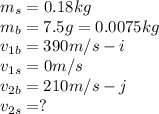
Physics, 07.10.2019 18:20 zitterkoph
0.180-kg stone rets on a frictionless, horizontal surface. a bullet of mass 7.50 g, traveling horizontally at 390 m/s, strikes the stone and rebounds horizontally at right angles to its original direction with a speed of 210 m/s.
(a) compute the magnitude and direction of the velocity of the stone after it is struck.

Answers: 2


Another question on Physics

Physics, 22.06.2019 02:30
Which feature of a heating curve indicates a change ofn state
Answers: 1

Physics, 22.06.2019 06:00
Suppose water is leaking from a tank through a circular hole of area ah at its bottom. when water leaks through a hole, friction and contraction of the stream near the hole reduce the volume of water leaving the tank per second to cah 2gh , where c (0 < c < 1) is an empirical constant. a tank in the form of a right-circular cone standing on end, vertex down, is leaking water through a circular hole in its bottom. (assume the removed apex of the cone is of negligible height and volume.) (a) suppose the tank is 20 feet high and has radius 8 feet and the circular hole has radius 2 inches. the differential equation governing the height h in feet of water leaking from a tank after t seconds is dh dt = − 5 6h3/2 . if the height of the water is initially 8 feet, how long will it take the tank to empty? (round your answer to two decimal places.)
Answers: 2

Physics, 22.06.2019 06:20
Clothing made of several thin layers of fabric with trapped air in between, often called ski clothing, is commonly used in cold climates because it is light, fashionable, and a very effective thermal insulator. so it is no surprise that such clothing has largely replaced thickand heavy old-fashioned coats. (a) consider a jacket made of five layers of 0.1-mm-thick synthetic fabric (k = 0.13 w/m·°c) with 1.5-mm-thick air space (k = 0.026 w/m·°c) between the layers. assuming the inner surface temperature of the jacket to be 28°c and the surface area to be 1.25 m2, determine the rate of heat loss through the jacket when the temperature of the outdoors is 0°c and the heat transfer coefficient at the outer surface is 25 w/m2·°c. (b) what would your response be if the jacket is made of a single layer of 0.5-mm-thick synthetic fabric? what should be the thickness of a wool fabric (k = 0.035 w/m·°c) if the person is to achieve the same level of thermal comfort wearing a thick wool coat instead of a five-layer ski jacket?
Answers: 1

Physics, 22.06.2019 09:00
One form of energy can be another type of energy. a. created to form b. transformed into c. destroyed and then created to form
Answers: 1
You know the right answer?
0.180-kg stone rets on a frictionless, horizontal surface. a bullet of mass 7.50 g, traveling horizo...
Questions


Mathematics, 19.10.2019 06:50




Health, 19.10.2019 06:50

Chemistry, 19.10.2019 06:50

English, 19.10.2019 06:50

English, 19.10.2019 06:50

Social Studies, 19.10.2019 06:50


Computers and Technology, 19.10.2019 06:50


Physics, 19.10.2019 06:50


Biology, 19.10.2019 06:50

History, 19.10.2019 06:50



English, 19.10.2019 06:50


 degrees from the horizontal.
degrees from the horizontal.







